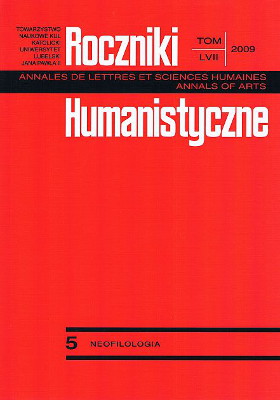Your Encounter with Ekphrasis
Abstrakt
[Abstrakt tylko w j. polskim / Abstract only in Polish]
Spotkanie z ekfrazą
Ekfraza jest starożytnym terminem retorycznym, używanym na określenie opisu dzieł plastycznych, ozdobnych waz, urn, dekoracyjnych tkanin, ale przede wszystkim malarstwa i rzeźby. Celem tego artykułu jest prześledzenie obecności ekfrazy we współczesnych badaniach literackich. Pojawienie się pojęcia ekfrazy w badaniach literackich łączy się z publikacją artykułu Leo Spitzera „The ‘Ode on a Grecian Urn,’ or Content vs. Metagrammar” (1962), gdzie ekfraza definiowana jest jako „poetycki opis malarstwa lub rzeźby.” Liczne przykłady opisów ekfrastycznych w prozie nie tylko XX wieku sprawiły, że również ekfraza, jako element prozy literackiej, stała się przedmiotem rozważań badawczych. Można nawet wyodrębnić coś, co w tym artykule nazywam „tendencją pronarracyjną” w ewolucji badań nad ekfrazą. Tendencja ta przejawia się wzrostem zainteresowania ekfrazą we współczesnej prozie narracyjnej (głównie – powieści). Artykuł ukazuje rozwój tendencji pro-narracyjnej w badaniach nad ekfrazą, a także polemizuje z jej niedawnymi osiągnięciami, zwłaszcza ze stanowiskiem Tamar Yacobi. Yacobi uważa, że w utworze narracyjnym najbardziej odpowiednia jest krótka ekfraza nieopisowa, nazwana przez nią „modelem ekfrastycznym”. Refleksja teoretyczna przedstawiona w artykule ma za zadanie dowieść, że tradycyjna ekfraza opisowa może konkurować z modelem ekfrastycznym, czyli znakomicie współpracować z utworem narracyjnym.
Bibliografia
Baldwin, C. S. Medieval Rhetoric and Poetic. New York: Macmillan, 1928.
Clüver, Claus. “Quotation, Enargeia, and the Functions of Ekphrasis.” In: Pictures into Words: Theoretical and Descriptive Approaches to Ekphrasis. Eds. Valerie Robillard and Els Jongeneel. Amsterdam: VU University Press, 1998. 35-52.
Genette, Gérard. Figures II: Essais. Paris: Seuil, 1969.
Genette, Gérard..Narrative Discourse: An Essay in Method. Trans. Jane E. Lewin. Ithaca: Cornell University Press, 1980.
Genette, Gérard..Figures of Literary Discourse. Trans. Alan Sheridan. New York: Columbia University Press, 1982.
Graf,Fritz. “Ekphrasis: Die Entstehung der Gattung in der Antike.” Beschreibungskunst – Kunstbeschreibung: Ekphrasis von der Antike bis zur Gegenwart. Eds. G. Boehm and H. Pfotenhauer. Munich: Wilhelm Fink, 1995. 130-152.
Hagstrum, Jean H. The Sister Arts: The Tradition of Literary Pictorialism from Dryden to Gray. Chicago: University of Chicago Press, 1958.
Hammond, N. G. L., and H. H. Scullard. Eds. Oxford Classical Dictionary. 2nd ed. Oxford: Clarendon Press, 1973.
Heffernan, James A. W. Museum of Words: The Poetics of Ekphrasis from Homer to Ashbery. Chicago: University of Chicago Press, 1993.
Krieger, Murray. “Ekphrasis and the Still Movement of Poetry; or Laokoön Revisited.” 1967. Reprinted in Ekphrasis: The Illusion of the Natural Sign: Baltimore: Johns Hopkins University Press, 1992. 263-288.
Krieger, Murray. Ekphrasis: The Illusion of the Natural Sign. Baltimore: Johns Hopkins University Press, 1992.
Kurman, George. “Ecphrasis in Epic Poetry.” Comparative Literature 26.1 (1974): 1-13.
Lessing, Gotthold Ephraim. Laocoön: An Essay upon the Limits of Painting and Poetry. Trans. Ellen Frothingham. New York: Dover Publications, Inc., 2005.
Lund, Hans. Text as Picture: Studies in the Literary Transformations of Pictures. Trans. Kacke Götrick. New York: The Edwin Mellen Press, 1992.
Raaberg, Gwen. “Ekphrasis and the Temporal/Spatial Metaphor in Murray Krieger’s Critical Theory.” New Orleans Review 12. 4 (1985): 34-43.
Robillard, Valerie. “In Pursuit of Ekphrasis (An Intertextual Approach).” Pictures into Words: Theoretical and Descriptive Approaches to Ekphrasis. Eds. Valerie Robillard and Els Jongeneel. Amsterdam: VU University Press, 1998. 53-72.
Saintsbury, George. A History of Criticism and Literary Taste in Europe. 2nd ed. Vol. 1. Edinburgh: William Blackwood & Sons Ltd., 1949.
Scott, Grant F. “The Rhetoric of Dilation: Ekphrasis and Ideology.” Word & Image 7.4 (1991): 301-310.
Simpson, J. A., and E. S. C. Weiner. Eds. Oxford English Dictionary. 2nd ed. Vol. 5. Oxford: Clarendon Press, 1991.
Spitzer, Leo. “The ‘Ode on a Grecian Urn,’ or Content vs. Metagrammar.” Essays on English and American Literature. Ed. Anna Hatcher. Princeton: Princeton University Press, 1962. 67-97.
Starzyk, Lawrence. “Browning and the Ekphrastic Encounter.” Studies in English Literature, 1500-1900 38.4 (1998): 689-706.
Steiner, Wendy. The Colors of Rhetoric: Problems in the Relation between Modern Literature and Painting. Chicago: University of Chicago Press, 1982.
Steiner, Wendy. Pictures of Romance: Form against Context in Painting and Literature. Chicago: University of Chicago Press, 1988.
Steiner, Wendy. “The Causes of Effect: Edith Wharton and the Economics of Ekphrasis.” Poetics Today 10.2 (1989): 279-297.
Yacobi, Tamar. “Pictorial Models and Narrative Ekphrasis.” Poetics Today 16.4 (1995): 600-649.
Yacobi, Tamar. “The Ekphrastic Model: Forms and Function.” In: Pictures into Words: Theoretical and Descriptive Approaches to Ekphrasis. Eds. Valerie Robillard and Els Jongeneel. Amsterdam: VU University Press, 1998. 21-34.
Copyright (c) 2009 Roczniki Humanistyczne

Utwór dostępny jest na licencji Creative Commons Uznanie autorstwa – Użycie niekomercyjne – Bez utworów zależnych 4.0 Międzynarodowe.





